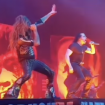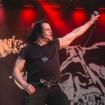Glenn Danzig spent decades walking the darker corners of rock & roll, passing through phases of blues, punk, goth and metal, and by the early Nineties he was on a hard-rock winning streak. With his namesake band, Danzig, the singer had established a powerful, feverish sound of his own over the quartet's first two albums, grappling with sex, religion, Armageddon and the demon world. What came next caught even him by surprise.
Danzig is not one for self-doubt, but the Evil Elvis was unprepared for the aftermath of Danzig III: How the Gods Kill. When the album was released in the summer of 1992, he recognized it as a creative step forward, and a further refinement of the band's sound. Then his agent informed the group their next Southern California gig would be at the 16,000-capacity Irvine Meadows Amphitheatre in Orange County — a big step up from their last local show at the 3,000-capacity Santa Monica Civic Auditorium.
"At that time, Irvine Meadows was relegated to bands like Bon Jovi and Whitesnake and big pop bands," Danzig tells Revolver. "For a band like Danzig, an underground metal band, it was unheard of going in and headlining the show. But we sold it out."
His growing audience was in response to Danzig III, which reached No. 24 on the Billboard album chart, landing at the meeting place for metal, classic hard rock and an alternative state of mind. Praised by Rolling Stone ("an originality that transcends genres"), dismissed by Spin magazine ("too goofy to be taken seriously"), the album reached into some unexpected places. "When we were on tour for the record, we'd be in a mall and you'd see your record at one of those mall record shops, which was unheard of," says Danzig. "Normally, you'd see a Danzig record at a record shop that catered to metalheads, punkers, alternative music."
"That was our biggest album," he says. "I was realizing as an artist what I really wanted to do, where I wanted to go and I'm trying to add different elements in, so it's not the same old record over and over, you know?"
His band was growing with him. On bass was Eerie Von, a Danzig collaborator since his previous band, Samhain. Drumming was Chuck Biscuits, who shared Danzig's deep roots in punk rock as a former member of Black Flag. "In my opinion he's the best drummer playing today," Danzig noted in an MTV interview that year. And back on guitar was John Christ, whose playing was only getting heavier.
"He was going through lots of different amps. He didn't like this, didn't like that," Danzig recalls of Christ, adding that pushing him "to be a little bluesier and less music school was the key. John did a really good job on the record."
There was one major shift in the lineup: While the first two Danzig albums were produced by Rick Rubin, on Danzig III the singer took control. Change was inevitable.

"I kept some of the stuff that Rick did because he did a lot of cool stuff on the first record. On the second record, he was kind of MIA," he notes, leading Danzig to take on producing Danzig III himself. "Rick executive produced it, but he was not really at the sessions. I had a certain sound in my head that I wanted it to sound like, and that's what I went for."
With experience producing Misfits and Samhain records, the role wasn't new to him. Basic tracks were recorded in Los Angeles at the Record Plant, then overdubs and vocals at Hollywood Sound. With Rubin no longer leading the production, Danzig began reintroducing elements to the band's sound that were stripped away on the first two albums.
"Rick has a kind of very stripped-out, clean approach. Some of the stripped-down stuff I like, but I like it a little noisier," he says. "It's probably a little more atmospheric because of stuff I added back in that maybe Rick would tend to take out. Sometimes Rick wants it very dry and in your face. We added some of the more atmospheric stuff — like timpani and things like that — on the record. 'How the Gods Kill' has got a guitar line that I wrote that's very hypnotizing."
The album opens with "Godless," a seven-minute epic and a message he calls "self-explanatory," with an unsurprising philosophy Danzig now describes as: "No god. No god whatsoever. No worshiping a god." After a tumbling drum intro from Biscuits and a slicing guitar riff from Christ, the song slows to an ominous Sabbath crawl, and Danzig wails of a "godless feeling in me night after night," as the song shifts in sound and tempo.
The message is more pointed in the album's title song, "How the Gods Kill," moving from delicate passages to eruptions of supercharged guitar and Danzig's bluesy growl: "If you feel alive/If you got no fear/Do you know the name/Of the one you seek?"
"It's really about coming to the realization that you can be your own god and you don't need other gods," he explains, "and how so many different gods end up making people kill. A lot of people don't want to think about how many different gods there are in the world that people worship, and how many of them force people to be destructive and murderous."
There's a real swing to his vocals, a looseness and expressiveness more in the tradition of his heroes Elvis or Roy Orbison than his metal contemporaries. "I don't really come from the metal world. I come from the punk world or bluesy world, but it's also kind of metallic at the same time," says Danzig now of the rawness and feeling within his vocals, which transcended genre and gave his music soul. "I have a deeper voice. I don't have that high, screechy metal voice."
What he did with that bluesy growl set Danzig and his band apart, established on the first two albums by Rubin's insistence that even the heaviest songs swing. "You'd literally sit in the studio and if he couldn't rock back and forth to it in a swing kind of manner he'd say, 'Do it over, do it over,'" recalls the singer. "You've got to be able to move to it. It's got to rock you back and forth. That's something I carried on."
Also carried on from the previous record was Danzig showing his range as a singer, from quiet to loud, vulnerable to enraged, from the wailing, bashing rock of "Bodies" to the delicate vocal on "Sistinas," a song he's described in the past as being about "depression, isolation, loneliness." On MTV's Headbangers Ball in 1992, he told host Riki Rachtman, "I like to take personal emotions and mix them with things I see around from other people."
On Danzig II, he'd shown a surprisingly tender side with "Blood and Tears," and on the follow-up, the singer did the same. "When you're doing a record, you try to show different sides," he says. "Maybe that was just a little more noticeable this time around."
The first single from the album was "Dirty Black Summer," which struts across a meaty riff, with accents of jittery guitar lines that echo classic Fifties rock & roll. The song was inspired by memories of his own adolescent summers, back when he was a teenage longhair from Lodi, New Jersey, and before the arrival of punk rock.
As he sings of "no holding back the summer night," Danzig recaptures the feelings of his early days when "you're out of school, having a great time, getting in trouble, drinking, not having to worry about going to school, hanging with your friends." He goes on, "By that time, I'm probably in and out of Manhattan all the time and hanging out there also. There's a lot of trouble to get in when you're young and you're stupid.
"It's not just about getting in trouble," he says, "but it's about summertime."
The track "Heart of the Devil" came from a different place, reaching back even further to his earliest inspirations in the blues, to the masters and originators who predated him by decades. So it's fitting that the song opens with Danzig shouting the lyrics without accompaniment, like a man alone at the devil's crossroads, looking to trade his soul or yours.
The song is equal parts warning and boasting, crafted from a tombstone hand and a graveyard mind. As growling creep-show guitars erupt, Danzig roars: "I can make a man freeze in his tracks/I can make a man fall to his death/I can make a girl so eager to please/I can make a young girl lay down for me/because I'm evil!"
"A lot of the stuff that I used to sing when I was a kid in bands was very bluesy," the singer says. "Sometimes it was blues. That's where I come from."

The first album he ever bought was by Howlin' Wolf, and he learned the names of the other great artists on Chess Records, including Willie Dixon, who was all over the Chess catalog as songwriter, bassist, producer, arranger, performer. Dixon and Muddy Waters were monumental figures in the Chicago blues that influenced the music of the Rolling Stones, Led Zeppelin, Cream and other hard rockers of the Sixties and Seventies. And in 1992, Danzig decided he wanted to write a song for Dixon and himself to record.
Danzig was comfortable collaborating with his cultural heroes. In 1987, he'd written and recorded "Life Fades Away" with Roy Orbison, and in 1994 he would write "Thirteen" for Johnny Cash. (More recently, he released an album of covers, Danzig Sings Elvis.)
"I thought about him when I was writing that song," Danzig says of the bluesman. "Usually when you hear me screaming and howl in a song, it's got a lot to do with Willie Dixon."
Danzig's agent, Marc Geiger, knew Dixon personally and made the connection. Dixon lived in the nearby city of Glendale, a quiet suburb of Los Angeles, and Danzig met Dixon there in the studio he had in his garage. "He was the coolest guy," recalls Danzig, who told Dixon about "Heart of the Devil." "He said, 'I would love to do it.' I'm a big blues fan, of course. Willie Dixon is somebody that I think doesn't get enough credit. Willie Dixon was the go-to guy. His phrasing when he's singing is amazing."
The plan was for Dixon to record the song with Danzig during sessions for the next album in Los Angeles. Danzig was going on tour, and would record the song when he returned. "While I was on the road, Marc called me and said, 'I've got bad news for you. He just passed away.'"
Dixon died of heart failure on January 29th, 1992. Danzig would record "Heart of the Devil" without him, and put the fiery track on Danzig III as a lasting tribute.
The album was mixed at the Hollywood studios of A&M Records, a top recording facility where decades of major rock acts congregated to create or finish their albums. When Danzig was finishing Danzig III: How the Gods Kill, Aerosmith was in the studio across the hall. "I got John [Christ] a stripper for his birthday," says Danzig, "and Steven Tyler came in to hang out and watch the stripper."
Strippers aside, it was at A&M, working with mixer Jason Corsaro, that the music Danzig and the band had created finally came into focus. "I remember listening back to How the Gods Kill with Jason and going, 'Wow, this is pretty cool,'" he says of his mixing sessions with Corsaro, who had worked on records for Motörhead, the Ramones and Madonna. "Usually with every record it's 20/20 — you go back and say, 'Oh, I could have fixed this. I could change that.' With How the Gods Kill there was a lot less of that than with some of the other records."
For the album cover, Danzig was drawn to the surrealist work of H.R. Giger and a 1976 painting titled Meister und Margeritha (translation: Master and Margarita). Like most of the world, Danzig first became fully aware of Giger through his bleak otherworldly designs for 1979's sci-fi horror classic Alien. He got even deeper into the Swiss artist's biomechanical renderings through a copy of Giger's oversized Necronomicon book that he saw at the comics and collectibles store Forbidden Planet in Manhattan.
"I was a big Giger fan, and somebody knew how to get in touch with him. I'm flipping through the books and I was like, 'This would be great,'" he recalls of landing on Meister und Margeritha as the final choice. Rubin agreed.
The airbrush painting Danzig chose depicts two alien creatures in an unsettling romantic embrace: teeth bared, tentacles flowing, skin translucent, tongues flicking. "I liked his subject matter. I liked the monochrome feel to it. It fit perfectly with Danzig III," Danzig says. For the album, he asked the artist to cover an erect penis depicted in the original with a long dagger and the band's horned skull logo.
Even with that appendage hidden, the album got assigned a "Parental Advisory/Explicit Content" sticker on its release, despite the absence of any profanity in the lyrics or in the artwork. The sticker hardly mattered. Danzig III: How the Gods Kill was released on July 14th, 1992, and the timing couldn't have been better.

In 1992, mainstream rock was going through a major shift — veering away from the hair-metal sound that had dominated MTV in the late Eighties, and embracing a darker, grungier sound led by Nirvana and Alice in Chains. Grittier superstars Guns N' Roses were still going strong, but something new was in the air. And the next wave was rooted in the punk and alternative world that for years had largely been dismissed as a niche by mainstream rock radio. It represented a fast-growing audience that was revealed by the first Lollapalooza tour in 1991. Nirvana's Nevermind landed later that year, and a new sound quickly dominated.
Few artists were better positioned to play a role in the changing environment than Danzig, whose bona fides as a punk-rock originator with the Misfits were undeniable. And his place in the metal world was long established, too. Danzig III straddled multiple hard-rock sounds and attitudes, so the band could easily share stages with the likes of Metallica, Black Sabbath, Soundgarden or Page and Plant, all touring partners in that era.
For the new album, Danzig exercised his lifelong interest in filmmaking by directing three music videos himself: for "Sistinas," the title song, and what he calls "a throwaway" video for "Bodies." The budgets were low.
"Rick would never give me a real budget to do music videos," Danzig says. "I don't think Rick wanted me to direct. He wanted me to just focus on doing the music. It wasn't going to deter me at all."
Danzig also had a documentary crew filming the making of Danzig III, and at the eye-opening Irvine Meadows concert, plus another week of shows across Europe. It amounts to an unfinished document of Danzig at a creative and popular peak, but he's never done anything with the footage and has no plans for it.
"Nah, YouTube killed home video," he says dismissively.

It sounds like a goldmine of material, but seems likely to remain in his vaults indefinitely. Even back in 1992 — despite all the success and notoriety from How the Gods Kill — he knew he'd be moving on to something else with Danzig 4 in two years.
"After that, I'm off going in another direction," Danzig says now. "That's where my mind is at: How do I make it different? How can I do this so that it's not exactly the same record, and people aren't just buying a regurgitated version of Danzig III? That's my mindset."












